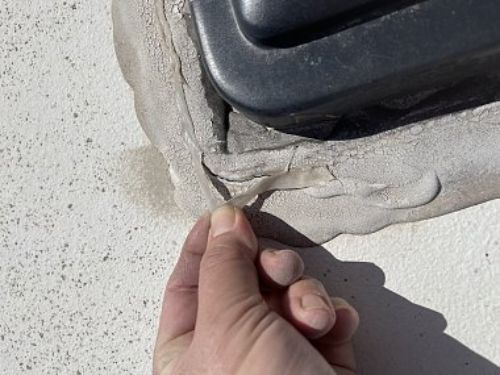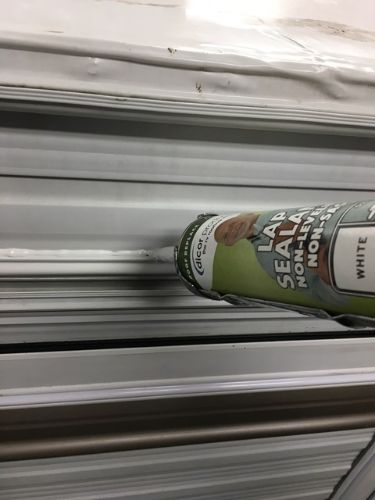How often should you recaulk your RV?
There are two answers to this question: the by-the-book answer, and the quick-and-dirty answer.
- By the book: Inspect all camper exterior seals every 90 days (or as often as your warranty requires). Reseal and recaulk as necessary. Replace all exterior seals every year.
- Quick n’ dirty: Inspect all camper exterior seals every 90-180 days. Reseal and recaulk as necessary. Replace all exterior seals every 3-7 years.
Both answers require you to inspect your RV every 3 to 6 months. But once outside of the initial 1- or 2-year warranty period, many RV owners choose to fully reseal their rigs every 3-7 years instead of annually.
Do pay attention to your warranty, though! If you do submit a claim related to a water leak, the first thing the manufacturer will check is proof that you’ve meticulously inspected and maintained your seals.
How Long Does RV Caulk Last?

There’s no one-size-fits-all answer to this question. If you use high-quality sealants, properly prepare the surfaces, and store your RV in a garage or carport, then your exterior seals can easily last 3-5 times longer than those on a neglected RV.
Even full-timers rarely reseal more than once a year. On the other hand, very few RVers can get away with more than 7-8 years between complete reseal jobs. By 8-10 years, leaks will usually have appeared and done their damage.
How to Inspect Your Camper Seals and Seams
A full inspection should take 15-30 minutes. This will require access to the roof, walls, and underbelly. Here’s a checklist of what to inspect:
- Roof fan
- Roof air conditioner
- Roof plumbing vents
- Roof lap seals
- Roof edge trim and gutter rail
- Roof fiberglass cap
- Wall entry doors
- Wall storage doors
- Wall windows
- Wall hatches and ports (water hatches, power plug, etc.)
- Wall marker and clearance lights
- Corner trim
- Base trim
- Slide-out gaskets
- Slide-out roof sides and top
- Slide-out wall bottom
- Underbelly/underfloor penetrations
- Any other roof or wall penetration
Don’t forget to look at the screw heads! A rusty screw head is often a sign that water has infiltrated the seal.
For further reading, check out my guide to resealing the exterior of your RV.
What Should I Use to Reseal My RV Roof and Walls?

Roof components should be sealed with a self-leveling sealant (although smaller roof components can be sealed with a lap sealant).
Wall components should be caulked with a non-sag caulk or elastomeric sealant.
Underfloor components should be sealed with low-viscosity non-sag sealants or spray foams.
For further reading, check out my list of favorite caulks and sealants.
When Should I Recaulk My RV Seams?
For many RVers, inspecting and resealing their RV is simply part of spring and winter maintenance. RVs should be sealed before being winterized to protect against leaks, and they should also be sealed before embarking on your summer adventures.
Caulk should be applied in moderately warm weather (50-70 degrees) in moderate humidity. While some sealants can be applied during or just before rain, many should remain dry for at least 24 hours to properly cure. The instructions should be printed on the tube of caulk itself.
Pro Tip: Many RVers choose to add an extra layer of protection to their rigs with EternaBond tape, which can be used as a corner seam tape or lap tape. Here’s a helpful video about using a similar tape, Dicor Seal-Tite, as a corner seam tape.
Do I Have to Remove the Old Caulking?
Generally, yes. Old caulk and sealant can be removed with a plastic putty knife, a razor scraper, or a Scotchbrite pad. Avoid sharp implements if possible, which can puncture, scratch, or otherwise damage your roof – and that could be a $10,000 mistake!
How Often Should I Reseal My RV Roof?
If you’re asking how often you should recoat your RV roof membrane (not the components), then that’s a separate question entirely!
- Many modern TPO and PVC RV roofing membranes do not require any periodic recoating.
- If you have an EPDM roof that requires recoating or reconditioning, most RVers will clean and reseal their EPDM roofs every 1-2 years.
- For a semi-permanent solution, consider an RV liquid rubber roof coating like RV Armor.
Leave a Reply